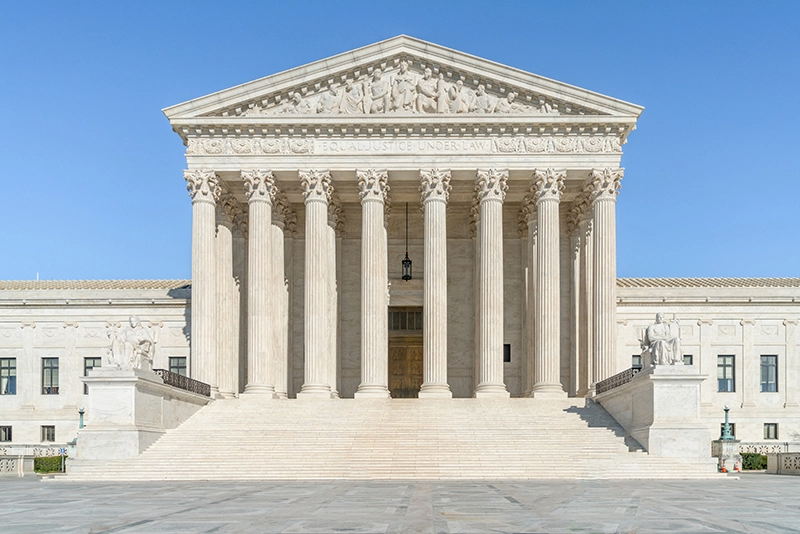Expect Immigration Fireworks as SCOTUS Heads into Its Final Month
There’s a certain irony in the fact that the lives of the citizens of a democratic republic can be drastically altered by the decisions of nine largely Ivy-League educated lawyers in Washington, D.C. Supreme Court decisions are now a fact of life, however, so expect fireworks in the next month as the Court issues its final decisions before it recesses for the summer — including in Texas v. U.S., which will likely answer many of the questions surrounding the president’s authority to not enforce the immigration laws.
The Pekoske and Tae Johnson Memos. Texas has followed a long and winding path on its way to the high court’s Marble Palace. That case started, as a practical matter, on January 20, 2021, when then-Acting DHS Secretary David Pekoske issued a memo captioned “Review of and Interim Revision to Civil Immigration Enforcement and Removal Policies and Priorities”.
The Pekoske memo limited DHS’s civil immigration enforcement priorities to three groups: spies and terrorists; aliens who entered illegally on or after the arbitrary date of November 1, 2020; and incarcerated aliens convicted of “aggravated felonies”, but only the ones “determined to pose a threat to public safety”.
The restrictions in that memo limited immigration officers’ ability not only to remove aliens who were not a priority, but even to stop and question them. The Pekoske memo also placed a 100-day moratorium on all removals.
The state of Texas quickly sued (in Texas v. Pekoske) to block that moratorium, and on January 26, 2021, Judge Drew Tipton of the U.S. District Court for the Southern District of Texas issued a temporary restraining order blocking it.
Thereafter, on February 18, 2021, Acting ICE Director Tae Johnson issued his own memo, captioned “Interim Guidance: Civil Immigration Enforcement and Removal Priorities”.
The Tae Johnson memo expanded on the enforcement priorities in the Pekoske memo ever so slightly. Spies, terrorists, and removable aliens who arrived on or after November 1 still made the list, but the February 18 guidance also included non-detained aggravated felons and certain gang members as enforcement priorities, if they “pose[] a risk to public safety”.
I have described and analyzed both of those memos several times in the past, but simply put, under the guise of “priorities” and “limited resources”, the Biden administration has shut down nearly all immigration enforcement in the interior, granting de facto amnesty to most illegal aliens, generally, and large numbers of criminal aliens in particular.
In response, in April 2021, the states of Texas and Louisiana filed a complaint challenging the Pekoske and Tae Johnson memos, which started the instant suit, Texas v. U.S., again heard by Judge Tipton.
The states asked Judge Tipton to enjoin both the Pekoske and the Tae Johnson memos, on two specific grounds.
First, section 236(c) of the Immigration and Nationality Act (INA) requires ICE officers to detain and hold any alien who is released from criminal custody if the alien is seeking admission or entered illegally and is removable on any of the criminal grounds of inadmissibility, or if the alien entered legally and is removable on all but one of the criminal deportation grounds.
Second, section 241(a) of the INA requires ICE to remove all aliens within 90 days after their removal orders have become final, and to detain them pending removal. For criminal aliens, release is even restricted: “Under no circumstance during the removal period shall [DHS] release an alien who has been found” inadmissible or deportable on criminal grounds.
On August 19, 2021, Judge Tipton issued an order enjoining the two memos, finding that neither ICE nor DHS had the discretion to ignore Congress’ mandates to arrest and detain criminal aliens. His decision focused on the operative word in both statutes, “shall”.
With respect to criminal aliens, section 236(c)(1) of the INA states that DHS “shall take” them into custody. Section 241(a)(2) of the INA states: “During the removal period, [DHS] shall detain” aliens removable on certain criminal grounds.
After an exhaustive analysis of those provisions, Judge Tipton concluded that the word “shall” found in each “means ‘must,’ imposing on the Government a duty to detain certain criminal aliens and those with final orders of removal when released [from criminal confinement] and during the removal period, respectively.”
Accordingly, he enjoined portions of that guidance that required ICE officers to seek permission before questioning, arresting, and detaining aliens who were covered by those provisions.
Judge Tipton stayed his injunction until August 30 to give the Biden administration the opportunity to appeal, which it did. On September 15, a three-judge panel of the Fifth Circuit issued a decision limiting the scope of that order, applying it only to two groups of aliens: criminals released from criminal confinement for whom ICE has issued a detainer, and aliens under final orders of removal.
At the time, I posited that the state would ask the whole Fifth Circuit to review Judge Tipton’s order, which is exactly what happened, as on November 30, 2021, the Fifth Circuit agreed to rehear, en banc, the administration’s appeal of Judge Tipton’s order, while vacating the three-judge panel decision.
The Mayorkas Memo. Those memos have been subsequently rescinded by a new one (“Guidelines for the Enforcement of Civil Immigration Law”), issued on September 30, 2021, by current DHS Secretary Alejandro Mayorkas. That one was effective November 29 — the day before the Fifth Circuit issued its en banc review ruling.
While not as restrictive in its scope as the prior two Biden administration memos, the Mayorkas memo requires immigration authorities (primarily but not exclusively ICE officers and attorneys) to consider so-called “aggravating” and “mitigating” factors that “militate” in favor of or against (respectively) the taking of enforcement action against facially removable aliens.
On December 6, 2021, the Biden administration asked the Fifth Circuit — with the state plaintiffs’ assent — to withdraw its appeal of Judge Tipton’s injunction to allow him to hear the states’ challenge to the Mayorkas memo.
At the end of that proceeding, on June 10, 2022, Judge Tipton issued an opinion vacating the Mayorkas memo.
He found that the memo increased the number of criminal aliens and aliens with final orders of removal who were being released into the plaintiff states and into the United States as a whole.
More saliently, however, and consistent with his earlier order, he concluded that sections 236(c) and 241(a) of the INA impose mandatory duties on DHS to take criminal aliens described therein into custody, duties with which the Mayorkas memo is in conflict.
He further held that Mayorkas’ recourse to prosecutorial discretion to not detain those aliens flouted the language of those provisions, Supreme Court precedent, and the legislative history of those provisions. Finally, he concluded that the state plaintiffs fell within the “zone of interests” those statutes were intended to protect.
The administration sought a stay of that latest order from the Fifth Circuit, which denied the request on July 6.
Most significantly, the three-judge panel determined that section 242(f)(1) of the INA — which deprives lower courts of the power to issue injunctive relief as the Supreme Court held on June 13 in Garland v. Aleman-Gonzalez — did not prevent Judge Tipton from vacating the Mayorkas memo.
The circuit court also rejected DHS’s contention that the Mayorkas memo “in no way binds enforcement agents and their superiors, but ‘simply ensures that discretion is exercised in an informed way’”. It concluded, to the contrary, that the memo deprived immigration officers of discretion to arrest and detain aliens they had previously possessed.
Similarly, the circuit panel rejected the government’s argument that the Mayorkas memo merely deals with issues that are committed to DHS’s discretion by Congress under the INA, finding that the memo “does not represent a one-off enforcement decision, but rather a calculated, agency-wide rule limiting ICE officials’ abilities to enforce statutory law”.
Supreme Court. That sent the administration scuttling to the Supreme Court for relief. On July 21, the justices denied the government’s request for a stay, but granted its request for certiorari before judgment, bypassing circuit court appeal of Judge Tipton’s order so that the justices could hear the case directly, which they did on November 29.
Much of the discussion at oral argument on that date concerned whether the state plaintiffs had standing to bring the case at all (though few of the justices appeared to doubt they did), but a key point, again, was whether the use of the word “shall” in the two INA provisions constrained the administration’s ability not to comply with those statutes.
U.S. Solicitor General (SG) Elizabeth Prelogar argued that those laws must be read as being discretionary because Congress hasn’t given DHS sufficient resources to enforce those mandates.
One practical problem with that argument is that the Mayorkas memo forces ICE officers, agents, and attorneys to use their limited resources to consider aggravating and militating factors Congress never told them to consider before taking enforcement action — a requirement that essentially wastes the resources the Biden policy contends it’s conserving.
In any event, Chief Justice Roberts asked Texas Solicitor General Judd Stone II — arguing for the state plaintiffs — whether DHS’s ability to comply with those restrictions shouldn’t inform the Court’s analysis of whether the words “shall take into custody” in section 236(c) of the INA should be interpreted as a mandatory directive notwithstanding DHS’s inherent prosecutorial discretion authority.
As Stone explained, “Congress actually considered” the administration’s “exact excuse” that it lacked resources to comply with the mandates in those provisions in 1996, when it added that provision to the INA in the Illegal Immigration Reform and Immigrant Responsibility Act (IIRIRA).
Included as part of the criminal alien detention provision in section 236(c) of the INA in IIRIRA were the “Transition Period Custody Rules”, which one court described as “a two-year grace period for application of the” detention mandates in that section.
As the states explained in their brief to the Court: “During that grace period, insufficient bed space could excuse INS’s mandatory duties under section [236(c) of the INA]. INS [ICE’s predecessor in interior enforcement] sought to extend the two-year period, but Congress refused, and the mandate took effect.”
Potential Implications. It’s unclear from the oral argument how a majority of the justices will rule, but the case has significant implications for both the Biden administration’s non-enforcement regime and state plaintiffs’ ability to challenge it.
If the Court were to rule that the states don’t have standing, there is little that other states could do to force the administration to enforce most of the INA. Conversely, if they do find that Texas and Louisiana have standing, it clears one significant hurdle in future suits.
And if the justices conclude that Biden’s DHS has broad discretion not to enforce the two INA provisions in question — which seemingly impose strict mandates on the department — it would drastically shift the authority to make immigration policy from Congress to the executive branch.
For example, the administration could next clear the massive backlog of removal cases currently pending before the immigration courts by either dismissing all of them (which would allow the alien respondents in those cases to stay) or stipulating to relief in all of them (ditto).
“Power of the Purse” and Impeachment. Interestingly, after Prelogar told the Court it couldn’t force DHS to apply the INA sections at issue, Justice Kavanaugh asked, “if courts aren’t going to be able to enforce those congressional mandates, what are the exact tools that Congress has to make sure that the laws are enforced in the United States?”
Prelogar responded: “Well, I think that Congress obviously has the power of the purse. It can make the executive’s life difficult with respect to its decisions about how to appropriate funds. Congress has oversight powers.”
I question whether the SG really wants the Republicans who control “the power of the purse” — that is, appropriations — in the House to force the Biden administration to comply with the mandates in the INA by “making the executive’s life difficult”, but it’s hard to view her statements as anything other than an invitation to do so.
Congress likely has no choice but to pay for additional Border Patrol resources and detention, but GOP leadership will likely be much choosier when it comes to other Biden asks, such as money to transport released migrants into the interior or for costly and ineffective “Alternatives to Detention”.
Justice Kavanaugh next carried Prelogar’s argument one step further, asserting:
I think your position is, instead of judicial review, Congress has to resort to shutting down the government or impeachment or dramatic steps if it — if some administration comes in and says we’re not going to enforce laws or at least not going to enforce the laws to the degree that Congress by law has said the laws should be enforced.
That one did not elicit much of a response, but should the Supreme Court find either that the states lack standing or that judges cannot force DHS to comply with the congressional enforcement mandates in the INA, don’t be surprised if their opinion also mentions impeachment — of the secretary and/or the president — as an alternative option for the legislative branch.
A Lot on the Line. There’s a lot on the line in Texas, both for the administration and for the states that are largely bearing the brunt of the president’s immigration and border policies. The Supreme Court is scheduled to adjourn on July 4 for the year, and of late it has kicked big immigration decisions to the last day of the session, so don’t be surprised if the justices deliver some fireworks of their own just before Independence Day.






